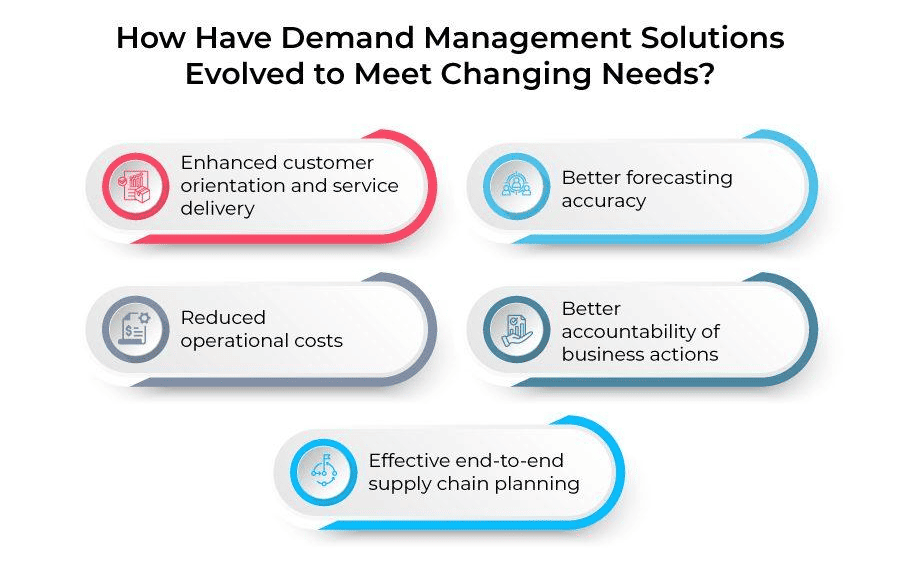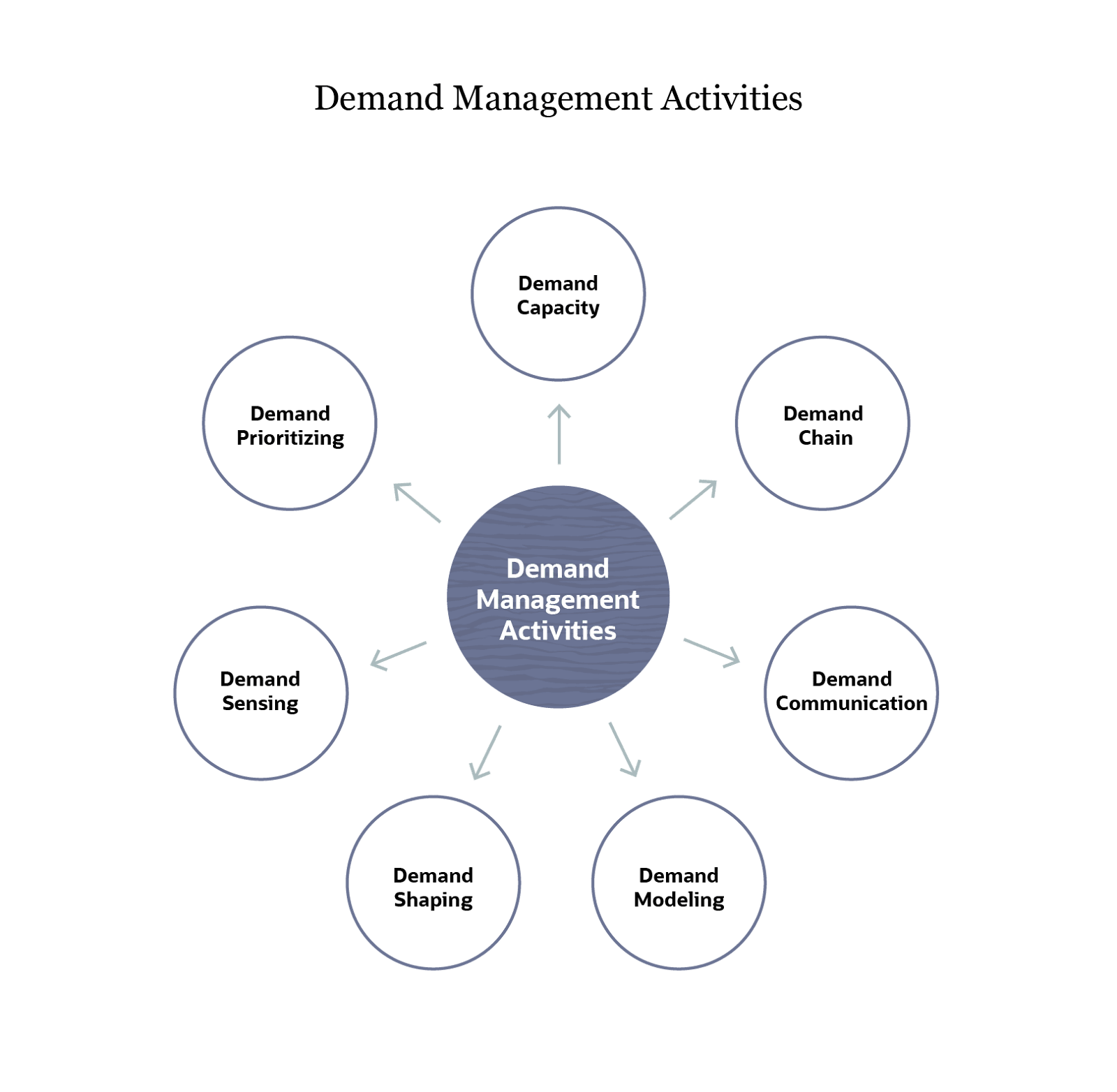- Features Features
- Pricing
- Login
- Start Free Trial Card not required

Through Demand management, organizations make it possible to meet all their customers' requirements and needs. Companies apply planning and controlling practices together with service and product management for reaching supply levels that support customer requirements.
A Company’s efficiency and profitability increase when demand management is done correctly. Also, effective resource planning allows companies to satisfy customer expectations without overloading their staff or exhausting their resources.
Managing your firm's demand levels leads to operational efficiencies while saving costs. The proper implementation of demand management yields multiple benefits to the organization.
1. The organization gains higher credibility to serve its customers while easier product launches, therefore become feasible.
2. The practice helps organizations create robust fundamental operational procedures that include merchandising together with budgeting and logistics systems.
3. A system exists that allows companies to detect supplier transaction changes along with full cost visibility.
4. Consumers develop durable relationships because discounts and reasonable product prices establish reliable customer relationships.
5. Demand management processes dependent on powerful modelling and forecasting technology together with demand and supply planning help enhance supply chain operations fluidity.
The three essential areas of demand management that are:
1. Customer service delivery
2. Improved forecasting models
3. Cost reduction projects
1. Enhance customer service - The organization can boost client satisfaction and service by understanding customer needs and behaviors.
2. Higher forecasting accuracy - Analytical forecasting enhances accuracy, which helps leaders at every level maximize supply chain operations through better choices.
3. Lowering costs - When forecasting reaches optimization, it leads businesses to cut their safety stock requirements and minimize inventory planning costs.
4. The development of new customer-oriented products - coupled with excellence in launching new products forms the key objective.
5. Better planning - A higher level of planning emerges through correct supply-to-demand ratios along with accurate data processes.
Throughout time, demand management solutions have experienced multiple transformations, which led to their continuous development.
Development in demand management solutions features flexibility as a core product to support changing priorities within organizations along with shifting market conditions.
Most organizations that experience expansion have redesigned their demand management methods through the years to reach these major targets:
Most companies have recognized that demand management systems require adjusted approaches to deliver good customer experiences. The evaluation of customer conduct and market requirements supports both enhanced efficiency in demand management and enables better customer satisfaction, leading to raised revenue levels.
Strategic demand management tools need predictive analytical capabilities that create valuable insights so that CSCOs can make their best possible decisions.
Supply chain management initiatives of these organizations become more certain through this ability.
Organizations that enhance forecast accuracy enable better synchronization of demand and inventory investments for improved stock position between overstocking and understocking.
The implementation of demand management leads to lower daily expenses from business operations.
By implementing transparent demand management systems, CSCOs protect both the responsibility of business initiatives and reduce potential obstacles to their business strategies.
The proper balance between supply and demand functions because of demand management, allowing businesses to view their value chain activities transparently while their units work more collaboratively.
The Demand management system operates through a variety of international elements and technological advances together with strategic corporate initiatives.
Various important trends will reshape the course of demand management throughout 2025 and its following years.
The main determining elements for demand management evolve as follows:
The adoption of Artificial Intelligence and Machine Learning systems will significantly improve analytical predictions for demand forecasting.
Businesses leverage scanning mechanisms for vast historical data tags to detect patterns that provide enhanced accuracy in predicting future demand levels. Time-sensitive tools integrated with AI can help demand management systems adapt their strategies instantly to present market conditions for better sudden demand response.
Businesses will adopt integrated systems that supply real-time visibility of data across their entire supply chain operation. The ability to monitor supply chain activities provides companies with better coordination along with smarter decision outputs and improved sales projections.
More companies in upcoming years will develop alliances with suppliers for creating shared demand predictions to maximize their production planning and warehouse management.
The public demands unified shopping encounters that unite different retail touchpoints, such as internet stores with physical outlets and handheld devices.
The system of demand management must develop capabilities to track and serve customer requests through multiple sales platforms. Because of increasing omnichannel popularity, demand management systems must adopt dynamic pricing strategies that track demand across all sales platforms.
Further development of demand management strategies will integrate eco-consumption values because sustainability maintains its role as an important decision factor for consumers.
Businesses need to develop expectations about the future market demand for eco-products while preventing avoidable product waste.
Customer operations will implement circular economy systems through lifecycle product approaches and waste reduction techniques. The present need is for more sophisticated demand management systems that optimize resource utilization.
Companies will implement advanced analytics for demand planning decisions starting from the year 2025 onward. The entire spectrum of demand sensing and segmentation, as well as scenario planning and risk analysis, will be included. Large-scale data analysis across various sources, including IoT devices and social media, and customer activity data, will enhance decision quality through forecasting and management decisions in demand management systems.
Organizations need to establish agile demand management processes for immediate changes in customer preferences and supply chain issues or economic forces and geopolitical factors.
Computing scenarios will become more widespread in businesses to help them discover potential disruptions so they can rapidly modify their strategies in unexpected demand pattern shifts.
The adoption of digital technology combined with automation will simplify diverse components in demand management operations, including inventory control and order logistics, and product transport throughout the supply chain.
Cloud-based platforms create easy collaboration between companies and suppliers alongside internal stakeholders and partners so they can respond quickly while improving their forecasting capabilities.
The emphasis of demand management systems should be on personalization through the systematic use of customer information to deliver custom-made products or services.
More accurate forecasting methods, together with flexible production systems, should be developed to adapt to modern customer-driven market demands.
Customer Voice insights through Voice of the Customer (VOC) enable companies to align their supply chain once they understand their precise product delivery times and locations that customers demand.
The rising complexity of worldwide supply routes will drive organizations to displace parts of their manufacturing processes and distribution while remaining close to customers.
The implementation of localized demand management systems based on regional preferences and valuable supply characteristics needs to occur. The combination of on-demand production and 3D printing will allow companies to manufacture products through actual consumer needs and avoid stockpiling large amounts of inventory.
The growing reliance on digital tools has elevated customer data security and business data privacy status to become ongoing demands for effective demand management.
High-security measures will be essential for protecting important demand forecasting data. Multinational businesses must follow strengthened data privacy laws, including GDPR, during customer data collection for demand forecasting activities.
The secure, tamper-proof blockchain system provides enhanced transaction records as a solution for better transparency in demand management procedures. Greater supply chain tracking together with fraud prevention result from this approach, which boosts customer trust.
The blockchain-based smart contracts automatize and execute demand-driven compliance processes together with performance optimization systems for suppliers.
The advanced development of demand management systems will drive organizations to recruit personnel trained in complex technological systems and data operations.
Organizations will spend money on boosting employee capabilities to use AI and data analytics along with digital tools. Effective demand management poses an increasing need for organizations to work with external partners such as vendors, consultants, and outsourcing partners to retain efficient planning operations.

Through demand management activities, teams gain opportunities to develop strategies that enhance the performance of their supply chain.
The seven activities included in demand management consist of are-
1. Demand Capacity
2. Demand Chain
3. Demand Communication
4. Demand Medelling
5. Demand Shaping
6. Demand Sensing
7. Demand Prioritizing

Every business needs its operations to reach equilibrium between supply and demand. The practice of demand management appears in organizations that operate both products and services.
Different industries follow demand management systems, which include cosmetics together with public utilities, and theme parks.
Worldwide exceeded $483 billion, as reported by Statista in 2021. Even though $483 billion seems like an impressive number, consumers shift toward new preferences that will replace current trends.
Cosmetic firms establish current trends through their celebrity-supported campaigns that promote their products. Cosmetic companies generate market demand before moving on to product distribution for sale.
This industry faces the same challenge of demand uncertainty while matching customer needs, just like cosmetic producers. Vehicle manufacturing leaders dedicate substantial financial and operational support to develop transparent supply chains that verify vendor economic sustainability when coping with varying customer market requirements.
This segment combines an integrated approach that applies to revenue management and marketing features together with financial and distribution capabilities within the hospitality industry. The amalgamation of hotel information into strategic insights helps organizations reduce their decision-making uncertainties.
They remain at its best within like -The Walt Disney Company.
Research at Disney allowed staff to determine the precise timeframe when queue guests need diversion from standing in lines. Research data revealed specific points when entertainment systems using mirrors with Disney characters and video presentations should be activated.
They operate demand-side management programs that fulfil regulatory standards by offering clients cost-saving opportunities. The ultimate measure of demand-side management initiatives, often referred to as energy efficiency programs, is to incentivize customers to achieve greater energy efficiency, thereby lowering overall electricity demand throughout the United States and other nations. Demand response programs minimize customer power consumption during critical emergencies, including fires or heat waves, and sudden freezing temperature events.
This division of MAXAIR Systems consists of ventilators as well as solutions that address both respiratory safety and contact protection needs. The COVID-19 pandemic caused air-purifying respirator sales at the company to soar sixfold, requiring an efficient system to manage its supply chain since production needed to meet rising demand.
The pandemic prompted the company leadership to adopt improved processing systems while delivering life-saving equipment.
The year 2025 will see demand management systems become more data-activated while introducing new technology infrastructure and improved service to consumers.
Digital transformation, together with AI implementation and Agile demand management strategies, provides essential requirements that businesses need to implement for future success.
Business organizations succeeding in the evolving demand market will achieve their goals through the effective integration of technological capabilities and sustainability considerations with customer needs.
Also read: